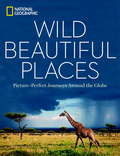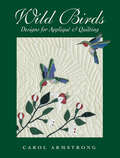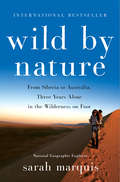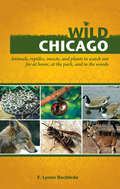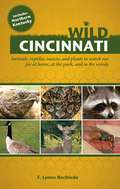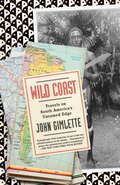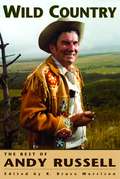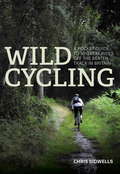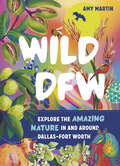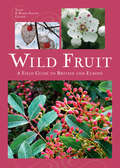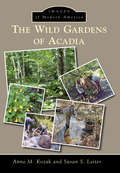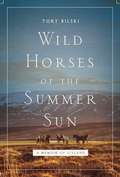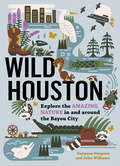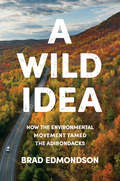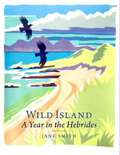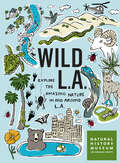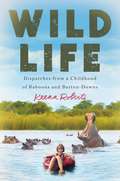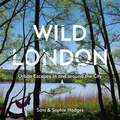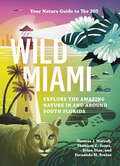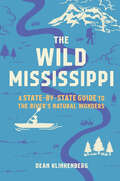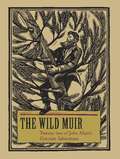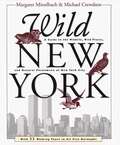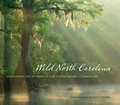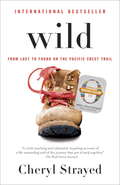- Table View
- List View
Wild, Beautiful Places: Picture-Perfect Journeys Around the Globe
by National Geographic George StoneExperience the world's most wild, remote, beautiful places with shots by National Geographic photographers and vintage photos pulled from the National Geographic archives. Highlighting 50 of Earth's most pristine, scenic locales, this beautiful book is illustrated with stunning images, coupled with accessible, engaging descriptions and practical travel information. The book covers everything from otherworldly, secluded valleys to far-flung, soaring mountain ranges. National Geographic photographers share some of their favorite shots from around the world and explain how they got them, and historical photos culled from National Geographic's hallowed image archive highlight old Society explorations in rugged, distant locations, and give a glimpse into the bygone days of these exotic places.From the Hardcover edition.
Wild Birds: Designs for Appliqué & Quilting
by Carol ArmstrongCarol again presents charming images inspired by her personal observations of nature. Use the designs of your favorite feathered friends to applique onto quilts, clothing, and home decor items. Complete directions for 8 projects. Includes 22 full-size patterns of birds such as Robin, Baltimore Oriole, Carolina Wren, Northern Cardinal, Killdeer, Hummingbird, Meadowlark, Redheaded Woodpecker, and many others. Detailed how-to instructions teach Carol's lightbox applique technique, a no-template method suitable for beginners as well as more experienced appliquers. Carol's unique background quilting patterns create shades and textures. Learn how to design bird patterns inspired by your own backyard visitors.
Wild by Nature: From Siberia to Australia, Three Years Alone in the Wilderness on Foot
by Sarah Marquis Stephanie HellertOne woman 10,000 miles on foot 6 countries 8 pairs of hiking boots 3,000 cups of tea 1,000 days and nights "The only way to survive three years of walking was to embrace the moment of now."--from Wild by Nature Not since Cheryl Strayed gifted us with her adventure on the Pacific Crest Trail in her memoir, Wild, has there been such a powerful epic adventure by a woman alone. In Wild by Nature, National Geographic Explorer Sarah Marquis takes you on the trail of her ten-thousand-mile solo hike across the remote Gobi desert from Siberia to Thailand, at which point she was transported by boat to complete the hike at her favorite tree in Australia. Against nearly insurmountable odds and relying on hunting and her own wits, Sarah Marquis survived the Mafia, drug dealers, thieves on horseback who harassed her tent every night for weeks, temperatures from subzero to scorching, life-threatening wildlife, a dengue fever delirium in the Laos jungle, tropic ringworm in northern Thailand, dehydration, and a life-threatening abscess. This is an incredible story of adventure, human ingenuity, persistence, and resilience that shows firsthand what it is to adventure as a woman in the most dangerous of circumstance, what it is to be truly alone in the wild, and why someone would challenge themselves with an expedition others would call crazy. For Marquis, her story is about freedom, being alive and wild by nature.
Wild Chicago
by F. Lynne BachledaHave you ever wondered what to do when a snake bit you? What if it is an animal you have never seen before? What if that plant is poisonous? Chicago residents need have no fear. In this new guide, Lynne Bachleda showcases the animals, places, and potential diseases that readers could encounter in the Chicago area. Bachleda touches on the mammals, birds, reptiles, amphibians, insects, arachnids, and flora that Chicago has to offer and she doesn't stop there. In this book, Bachleda explains how to keep safe and what to do in case you are injured by an animal or contract a disease from an animal or plant.
Wild Cincinnati
by F. Lynne BachledaNow readers can explore the Cincinnati area without fear and feel prepared in case they encounter any of these dangerous creatures or diseases. In this new guide, Lynne Bachleda showcases the animals, places, and potential diseases that readers could encounter in the Cincinnati area. Bachleda touches on the mammals, birds, reptiles, amphibians, insects, arachnids, and flora that Cincinnati has to offer and she doesn't stop there. She explains how to keep safe and what to do in case you are injured by an animal or contract a disease from an animal or plant. Some of the animals Bachleda features include coyotes, cockroaches, bees, lice, hornets, bed bugs, and Northern copperheads. Bachleda also includes some prominent diseases such as histoplasmosis, encephalitis, Rocky mountain spotted fever, lyme disease, plague, malaria, scabies, and more.
Wild Coast: Travels on South America's Untamed Edge
by John GimletteGuyana, Suriname, and French Guiana are among the least-known places in South America: nine hundred miles of muddy coastline giving way to a forest so dense that even today there are virtually no roads through it; a string of rickety coastal towns situated between the mouths of the Orinoco and Amazon Rivers, where living is so difficult that as many Guianese live abroad as in their homelands; an interior of watery, green anarchy where border disputes are often based on ancient Elizabethan maps, where flora and fauna are still being discovered, where thousands of rivers remain mostly impassable. And under the lens of John Gimlette--brilliantly offbeat, irreverent, and canny--these three small countries are among the most wildly intriguing places on earth. On an expedition that will last three months, he takes us deep into a remarkable world of swamp and jungle, from the hideouts of runaway slaves to the vegetation-strangled remnants of penal colonies and forts, from "Little Paris" to a settlement built around a satellite launch pad. He recounts the complicated, often surprisingly bloody, history of the region--including the infamous 1978 cult suicide at Jonestown--and introduces us to its inhabitants: from the world's largest ants to fluorescent purple frogs to head-crushing jaguars; from indigenous tribes who still live by sorcery to descendants of African slaves, Dutch conquerors, Hmong refugees, Irish adventurers, and Scottish outlaws; from high-tech pirates to hapless pioneers for whom this stunning, strangely beautiful world ("a sort of X-rated Garden of Eden") has become home by choice or by force. In Wild Coast, John Gimlette guides us through a fabulously entertaining, eye-opening--and sometimes jaw-dropping--journey.
Wild Country: The Best of Andy Russell
by Andy RussellCanada’s mountain man shares his best wilderness adventure stories Though Andy Russell has been many things in his life – hunter, trapper, trail guide, wilderness photographer and filmmaker, conservationist, and activist – he is, above all else, a master storyteller. This collection of twenty-four stories, selected and introduced by R. Bruce Morrison, includes Andy’s accounts of growing up on a ranch near the Rocky Mountains; hunting with a rifle, fishing rod, and camera; and encounters with wildlife large and small. He describes the warmth of a campfire shared with loved ones and the feeling of being part of something greater than himself. Andy writes about the animals he has lived and worked with, such as Seppi, his trusty hunting dog; Ace, his courageous trail horse; and Amos, the pack horse with a high I. Q. He also retells the stories of his friends and family, some that will make your hair stand on end, such as the time his father-in-law jumped off a log almost right into a grizzly’s lap or when his son stood eight feet from a grizzly and argued with it until they parted ways… intact. Some of the stories are funny, others are compelling and inspiring. This collection is a testament to over sixty years of living in Canada’s wild places.
Wild Cycling: A pocket guide to 50 great rides off the beaten track in Britain (Wild Cycling)
by Chris Sidwells'A wildly inspiring adventure - from armchair to saddle.'Nichiless'A lovely concise guide.'A. W. BairdHere is plenty of inspiration for anyone who loves to ride off road and get out into the wild and stunning scenery of the British mainland. Each route suggests further routes and the book as a whole introduces the wild cyling potential of a range of different locations. These natural routes to wild places link country lanes, green lanes, bridleways, towpaths, trails and often ancient ways between places. The book is illustrated in colour and each ride includes an annotated route map and ride profile, also OS grid references. And a fact file gives further indispensable details, including an indication of how hard each ride is, and how wild. From Chalk Cliffs and Curious Sound Mirrors in the south-east to Cape Wrath in the north-west, the purity, beauty and essential wildness of these rides will ensure that over the years many of them will become classic, even legendary cycling challenges.
Wild Cycling: A pocket guide to 50 great rides off the beaten track in Britain
by Chris SidwellsHere is plenty of inspiration for anyone who loves to ride off road and get out into the wild and stunning scenery of the British mainland. Each route suggests further routes and the book as a whole introduces the wild cyling potential of a range of different locations. These natural routes to wild places link country lanes, green lanes, bridleways, towpaths, trails and often ancient ways between places. The book is illustrated in colour and each ride includes an annotated route map and ride profile, also OS grid references. And a fact file gives further indispensable details, including an indication of how hard each ride is, and how wild. From Chalk Cliffs and Curious Sound Mirrors in the south-east to Cape Wrath in the north-west, the purity, beauty and essential wildness of these rides will ensure that over the years many of them will become classic, even legendary cycling challenges.
Wild DFW: Explore the Amazing Nature In and Around Dallas–Fort Worth (Wild Ser.)
by Amy MartinDiscover all the unexpected nature Dallas-Fort Worth has to offer with this enlightening guidebook! Dallas-Fort Worth is more than just a bustling metroplex, it&’s full of amazing wildlife. You just need to know where to find it! Equal parts natural history, field guide, and trip planner, Wild DFW has something for everyone. This handy yet extensive guide looks at the factors that shape local nature and profiles over 100 local species, from American basket-flowers and pecan trees to bald eagles, nine-banded armadillos, and Texas spiny lizards. Twenty-five day trips help you find and explore these natural wonders on hiking trails, in public parks, and in your own backyard.
Wild Fruit: A Field Guide to Britain and Europe
by Alain GeneveWild Fruit is a field guide to fruit commonly found in the wild in Britain and Northern Europe. The plant descriptions include information on identification for 220 fruits, and include tasting notes and historical information about the plant’s medicinal uses. Over 400 color photographs show the plants at different points in their maturity, aiding in accurate identification.
The Wild Gardens of Acadia (Images of Modern America)
by Anne M. Kozak Susan S. LeiterFounded in 1961 at Sieur de Monts Spring in Maine's Acadia National Park, the Wild Gardens of Acadia display, preserve, propagate, and label native plants in areas simulating natural plant communities. The gardens, which originated from a competition in growing native plants sponsored by the Bar Harbor Garden Club, continue to be developed and maintained by volunteers in partnership with Friends of Acadia and Acadia National Park. Each of the gardens' 13 habitats, ranging from mountain to beach to bog to deciduous and coniferous woods, displays plants native to the park. Since the founding, countless park visitors have come to the gardens to identify plants they have seen on walks or hikes or to learn more about cultivating native plants. Many of the images in this book are drawn from the extensive photograph collection of the Wild Gardens of Acadia.
Wild Horses of the Summer Sun: A Memoir Of Iceland
by Tory BilskiA wondrous story of adventure and friendship featuring a group of women who ride Icelandic horses. "Blame it or praise it, there is no denying the wild horse in us."—Virgina Woolf Each June, Tory Bilski meets up with fellow women travelers in Reykjavik where they head to northern Iceland, near the Greenland Sea. They escape their ordinary lives to live an extraordinary one at a horse farm perched at the edge of the world. If only for a short while. When they first came to Thingeryar, these women were strangers to one another. The only thing they had in common was their passion for Icelandic horses. However, over the years, their relationships with each other deepens, growing older together and keeping each other young. Combining the self-discovery Eat, Pray, Love, the sense of place of Under the Tuscan Sun, and the danger of Wild, Wild Horses of the Summer Sun revels in Tory's quest for the "wild" inside her. These women leave behind the usual troubles at home: affairs, sick parents, troubled teenagers, financial worries—and embrace their desire for adventure. Buoyed by their friendships with each other and their growing attachments and bonds with the otherworldly horses they ride, the warmth of Tingeryar's midnight sun carries these women through the rest of the year's trials and travails. Filled with adventure and fresh humor, as well as an incredible portrait of Iceland and its remarkable equines, Wild Horses of the Summer Sun will enthrall and delight not just horse lovers, but those of us who yearn for a little more wild in everyday life.
Wild Houston: Explore the Amazing Nature in and around the Bayou City
by Suzanne Simpson John WilliamsThis vibrant, informative guide shows the unexpected and amazing nature in Houston and the surrounding area just waiting to be explored. Houston is more than just a bustling metroplex, it's full of amazing wildlife. You just need to know where to find it! Equal parts natural history, field guide, and trip planner, Wild Houston has something for everyone. This handy yet extensive guide looks at the factors that shape local nature and profiles over 100 local species, from the Barred Owl and the Western Rat Snake to the Houston Burrowing Crayfish, the Rainbow Scareb, and the Nine-banded Armadillo. Also included are descriptions of day trips that help you explore natural wonders on hiking trails, in public parks, and in your own backyard.
A Wild Idea: How the Environmental Movement Tamed the Adirondacks
by Brad EdmondsonA Wild Idea shares the complete story of the difficult birth of the Adirondack Park Agency (APA). The Adirondack region of New York's rural North Country forms the nation's largest State Park, with a territory as large as Vermont. Planning experts view the APA as a triumph of sustainability that balances human activity with the preservation of wild ecosystems. The truth isn't as pretty. The story of the APA, told here for the first time, is a complex, troubled tale of political dueling and communities pushed to the brink of violence. The North Country's environmental movement started among a small group of hunters and hikers, rose on a huge wave of public concern about pollution that crested in the early 1970s, and overcame multiple obstacles to "save" the Adirondacks. Edmondson shows how the movement's leaders persuaded a powerful Governor to recruit planners, naturalists, and advisors and assign a task that had never been attempted before. The team and the politicians who supported them worked around the clock to draft two visionary land-use plans and turn them into law. But they also made mistakes, and their strict regulations were met with determined opposition from local landowners who insisted that private property is private.A Wild Idea is based on in-depth interviews with five dozen insiders who are central to the story. Their observations contain many surprising and shocking revelations. This is a rich, exciting narrative about state power and how it was imposed on rural residents. It shows how the Adirondacks were "saved," and also why that campaign sparked a passionate rebellion.
Wild Island: A Year in the Hebrides
by Jane SmithThis memoir of a year on a virtually uninhabited Scottish island, including illustrations of flora and fauna, is &“the next best thing to being there&” (Scotland on Sunday).Wild Island depicts a year in the life of Oronsay, a remote Scottish island that is farmed by the Royal Society for the Protection of Birds, and follows artist Jane Smith as she attempts to portray the interactions of wildlife, farm animals, and a small number of human inhabitants. A humorous, first-hand, personal view of island life, both human and otherwise, the book is illustrated with Smith&’s vibrant and acutely observed sketches, paintings, and prints. She invites us into her world as she delves into such questions as: What does it feel like to sit in a bog all day? Where are a bird's knees? And why do I always wind up covered in acrylic paint? Musing on encounters with creatures from otters to oil beetles, conservation management, and the tides, winds, and ferries that affect each journey to and from the island, Smith offers a beautiful portrait of a special place—and shares the ridiculous things that happen when living on a remote island, cut off from the rest of the world.
Wild LA: Explore the Amazing Nature in and Around Los Angeles
by Jason G. Goldman Natural History Museum of Los Angeles County Lila M. Higgins Gregory B. Pauly Charles Hood“Put on your hiking shoes, pack your binoculars, and rediscover the City of Angels.” —Westways Magazine Los Angeles may have a reputation as a concrete jungle, but in reality, it's full of amazing wildlife. You just need to know where to find it! Equal parts natural history, field guide, and trip planner, Wild LA has something for everyone. It looks at the factors that shape local nature—including fire, floods, and climate—and profiles over 100 local species, from easy-to-spot squirrels and praying mantids to more elusive green sea turtles, bighorn sheep, and mountain lions. Also included are descriptions of day trips that help you explore natural wonders on hiking trails, in public parks, and in your own backyard.
Wild Life: Dispatches from a Childhood of Baboons and Button-Downs
by Keena RobertsDon't Let's Go to the Dogs Tonight meets Mean Girls in this funny, insightful fish-out-of-water memoir about a young girl coming of age half in a "baboon camp" in Botswana, half in a ritzy Philadelphia suburb.Keena Roberts split her adolescence between the wilds of an island camp in Botswana and the even more treacherous halls of an elite Philadelphia private school. In Africa, she slept in a tent, cooked over a campfire, and lived each day alongside the baboon colony her parents were studying. She could wield a spear as easily as a pencil, and it wasn't unusual to be chased by lions or elephants on any given day. But for the months of the year when her family lived in the United States, this brave kid from the bush was cowed by the far more treacherous landscape of the preppy, private school social hierarchy.Most girls Keena's age didn't spend their days changing truck tires, baking their own bread, or running from elephants as they tried to do their schoolwork. They also didn't carve bird whistles from palm nuts or nearly knock themselves unconscious trying to make homemade palm wine. But Keena's parents were famous primatologists who shuttled her and her sister between Philadelphia and Botswana every six months. Dreamer, reader, and adventurer, she was always far more comfortable avoiding lions and hippopotamuses than she was dealing with spoiled middle-school field hockey players. In Keena's funny, tender memoir, Wild Life, Africa bleeds into America and vice versa, each culture amplifying the other. By turns heartbreaking and hilarious, Wild Life is ultimately the story of a daring but sensitive young girl desperately trying to figure out if there's any place where she truly fits in.
Wild London: Urban Escapes in and around the City
by Sam Hodges Sophie HodgesFrom the authors of London for Lovers, this is an inspiring and comprehensive guide to London’s wild side. From exploring secret gardens, parks, farmers markets and city farms, to discovering the best spots for urban bee-keeping, foraging, open-air swimming and mudlarking, Wild London is packed with ideas for how to make the most of London’s hidden natural wonder. Separated by season, and filled with stunning photographs, this is a must-have, practical and eye-opening guide to alternative London for city-dwellers and visitors alike.
Wild Miami: Explore the Amazing Nature in and Around South Florida
by TJ Morrell Shannon Jones Brian Diaz Fernando BretosA vibrant, family-friendly guide to the unexpected nature found in and around Miami. Miami may be a bustling city with a vibrant nightlife, but its wildlife is just as wild, if you know where to look. Wild Miami reveals the amazing ecology of this tropical metropolis. Equal parts natural history, field guide, and trip planner, Wild Miami has something for everyone. This handy yet extensive guide looks at the factors that shape local nature and profiles over 100 local species, from beautiful flowers and towering palm trees to manatees and green treefrogs, spotted sunfish, and great blue heron. Also included are descriptions of day trips that help you explore natural wonders on hiking trails and beaches, in public parks, and in your own backyard.
The Wild Mississippi: A State-by-State Guide to the River's Natural Wonders
by Dean KlinkenbergDiscover the amazing flora and fauna of the Mississippi River—and the best ways to explore it, state by state! Did you know that one-quarter of all North American fish species are native to the Mississippi? Or that it shelters 300 species of birds during seasonal migrations? The Mississippi River runs through the heart of the nation, shaping its history and identity. But few of us understand its essences. It&’s a life-giving force that sustains thriving ecosystems across wetlands, prairies, and bluffs. In The Wild Mississippi, Dean Klinkenberg not only shares the wonders of the river, but he also shows you where to experience them firsthand. Pick up this must-read guide and get ready to experience the river wild! You&’ll discover: Hiking, biking, and paddling spots More than 160 parks, forests, and wildlife refuges Natural history museums and aquariums Excursions from Minneapolis, St. Louis, Memphis, New Orleans, and more
The Wild Muir
by Lee StetsonHere is an entertaining collection of John Muir's most exciting adventures, representing some of his finest writing. From the famous avalanche ride off the rim of Yosemite Valley to his night spent weathering a windstorm at the top of a tree to death-defying falls on Alaskan glaciers, the renowned outdoorsman's exploits are related in passages that are by turns exhilarating, unnerving, dizzying, and outrageous.
Wild New York: A Guide to the Wildlife, Wild Places, and Natural Phenomenon of New York City
by Michael Crewdson Margaret MittelbachBreathing new life into the city, Wild New York takes a completely fresh look at the ultimate metropolis. This beautifully illustrated and deftly written natural history uncovers the surprising range of wildlife and natural phenomena that not only survive but flourish within the unlikely confines of New York City--from the bedrock supporting Manhattan's skyscrapers to the hundreds of different animals that dwell, unsuspected, in the city's waterways and parks. Complete with handy maps and detailed excursions throughout the five boroughs, Wild New York is also an indispensable guidebook for the urban explorer. With directions for 33 walking tours, the book encourages readers to explore the city's hidden and not-so-hidden natural corners and to experience the diversity of wildlife inhabiting the city--including peregrine falcons nesting above Grand Central Station, snapping turtles lurking in Central Park's ponds, and jackrabbits living beside the runways at John F. Kennedy Airport.
Wild North Carolina Discovering The Wonders of Our State's Natural Communities
by David Blevins Michael P. SchafaleCelebrating the beauty, diversity, and significance of the state's natural landscapes,Wild North Carolinaprovides an engaging, beautifully illustrated introduction to North Carolina's interconnected webs of plant and animal life. From dunes and marshes to high mountain crags, through forests, swamps, savannas, ponds, pocosins, and flatrocks, David Blevins and Michael Schafale reveal in words and photographs natural patterns of the landscape that will help readers see familiar places in a new way and new places with a sense of familiarity. Wild North Carolinaintroduces the full range of the state's diverse natural communities, each brought to life with compelling accounts of their significance and meaning, arresting photographs featuring broad vistas and close-ups, and details on where to go to experience them first hand. Blevins and Schafale provide nature enthusiasts of all levels with the insights they need to value the state's natural diversity, highlighting the reasons plants and animals are found where they are, as well as the challenges of conserving these special places.
Wild (Oprah's Book Club 2.0 Digital Edition): From Lost to Found on the Pacific Crest Trail
by Cheryl StrayedOprah's Book Club 2.0 selection: This special eBook edition of Cheryl Strayed's national best seller, Wild, features exclusive content, including Oprah's personal notes highlighted within the text, and a reading group guide. A powerful, blazingly honest memoir: the story of an eleven-hundred-mile solo hike that broke down a young woman reeling from catastrophe--and built her back up again.At twenty-two, Cheryl Strayed thought she had lost everything. In the wake of her mother's death, her family scattered and her own marriage was soon destroyed. Four years later, with nothing more to lose, she made the most impulsive decision of her life: to hike the Pacific Crest Trail from the Mojave Desert through California and Oregon to Washington State--and to do it alone. She had no experience as a long-distance hiker, and the trail was little more than "an idea, vague and outlandish and full of promise." But it was a promise of piecing back together a life that had come undone.Strayed faces down rattlesnakes and black bears, intense heat and record snowfalls, and both the beauty and loneliness of the trail. Told with great suspense and style, sparkling with warmth and humor, Wild vividly captures the terrors and pleasures of one young woman forging ahead against all odds on a journey that maddened, strengthened, and ultimately healed her.
